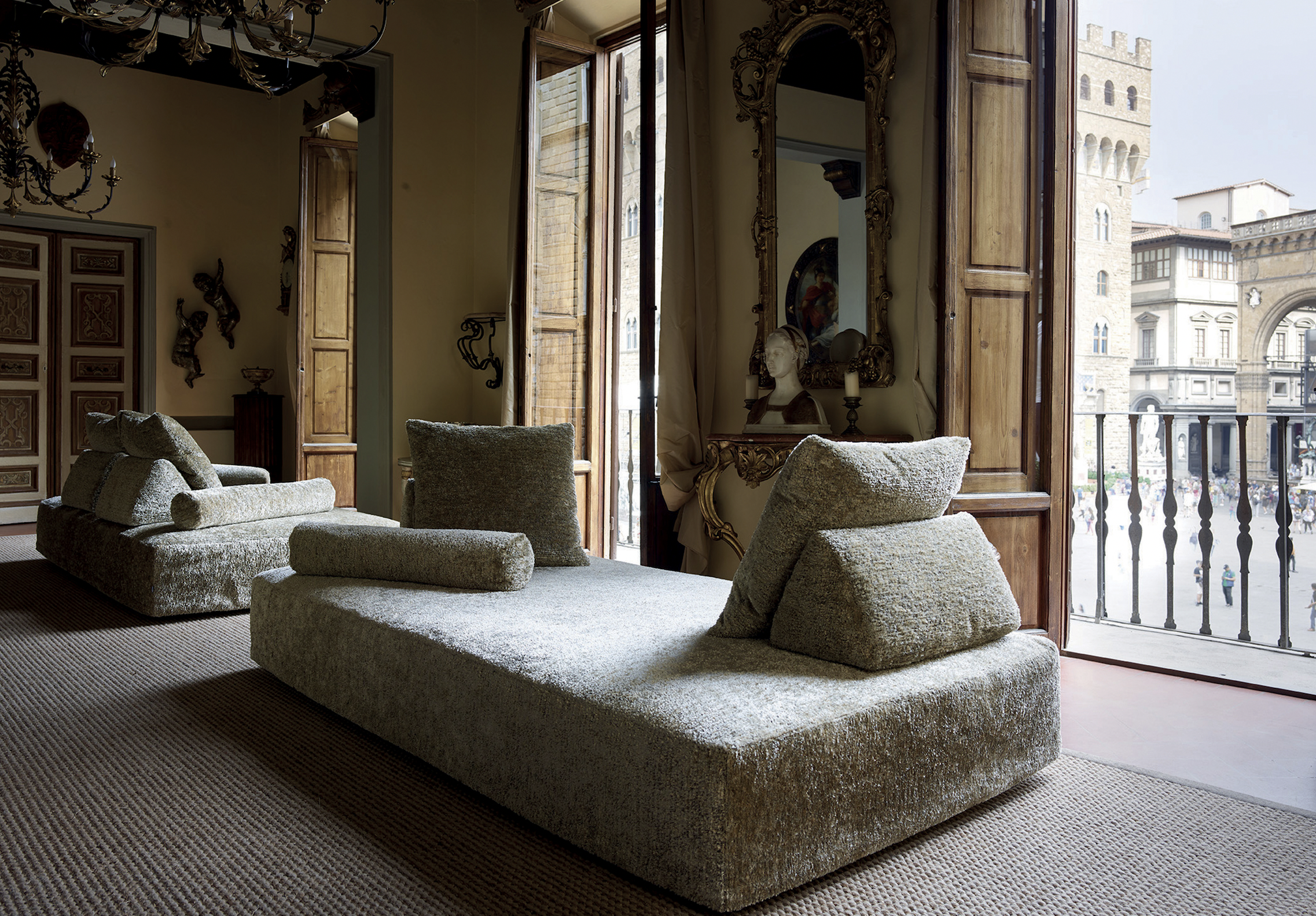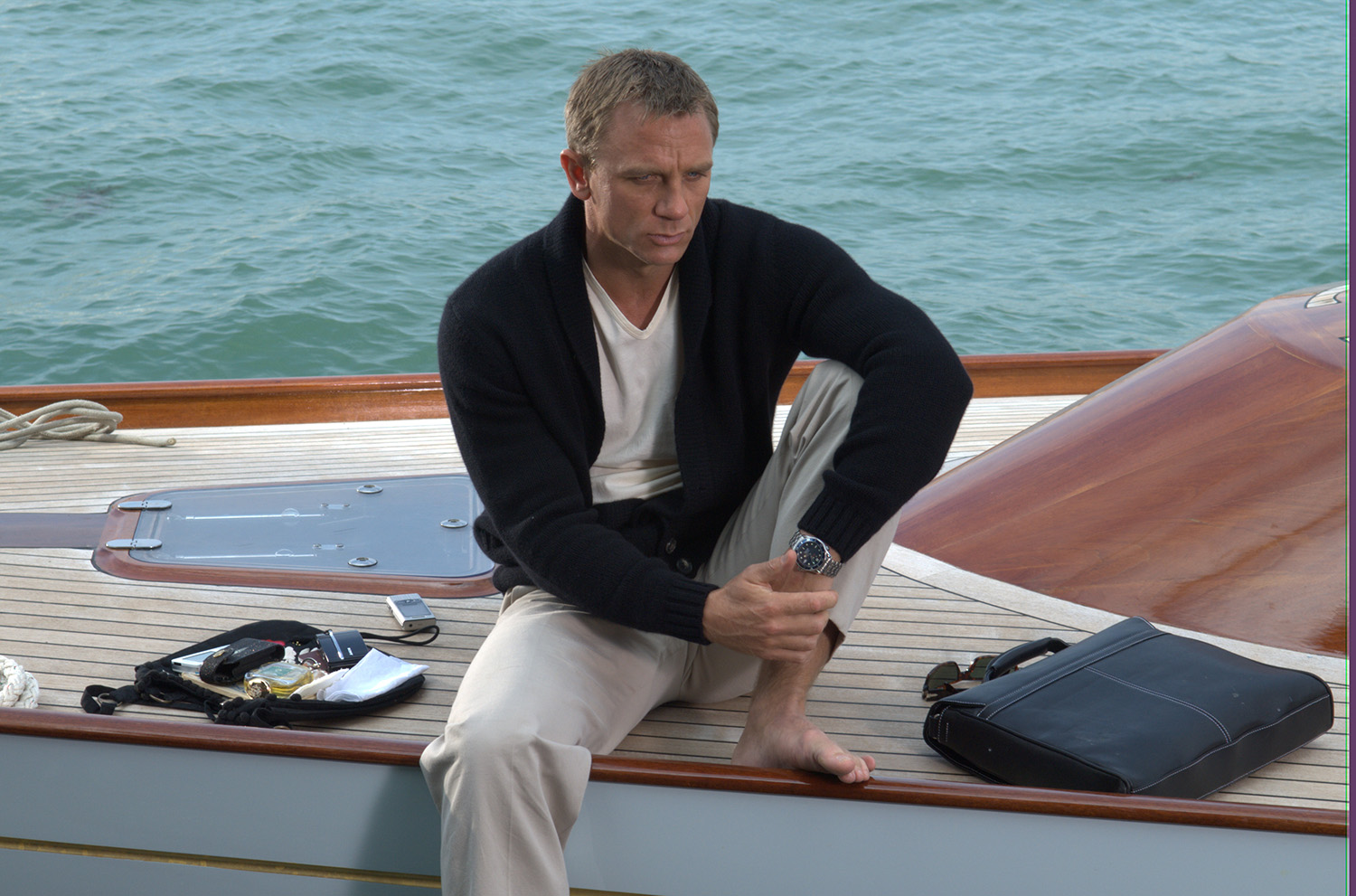
James Bond And The Science Of Fiction
In many Bond movies, 007’s mind-blowing timepieces save the day. But are they really so far-fetched?
Related articles
There have been many characters over the years touted as the “real-life” James Bond, a list usually drawn from the various spies and adventurers that his creator, Ian Fleming, met during his time in Naval Intelligence during WWII. Equally, there are several contenders for being the inspiration behind Q, the boffin who heads up Q (for Quartermaster) Branch – Fleming’s fictitious version of what is now known as Her Majesty’s Government Communications Centre – the department that provides 007 with his famous gadgets.
My favourite of these candidates for the prototype Q is Christopher Clayton Hutton, of the little-known branch of military intelligence called MI9. Its role in WWII was to help downed aircrew and escaped prisoners of war get back to the UK, using a series of escape lines across Europe, and Hutton’s job was to provide the equipment to assist in what was known as Escape and Evasion, a phrase which accurately describes much of Bond’s activity during a mission. So Clutty, as he was known, created maps concealed in playing cards; compasses hidden in buttons or collar studs; powerful flashlights disguised as bicycle pumps; multi-function ‘escape knives’, tiny radios and a cigarette lighter with a concealed camera inside.
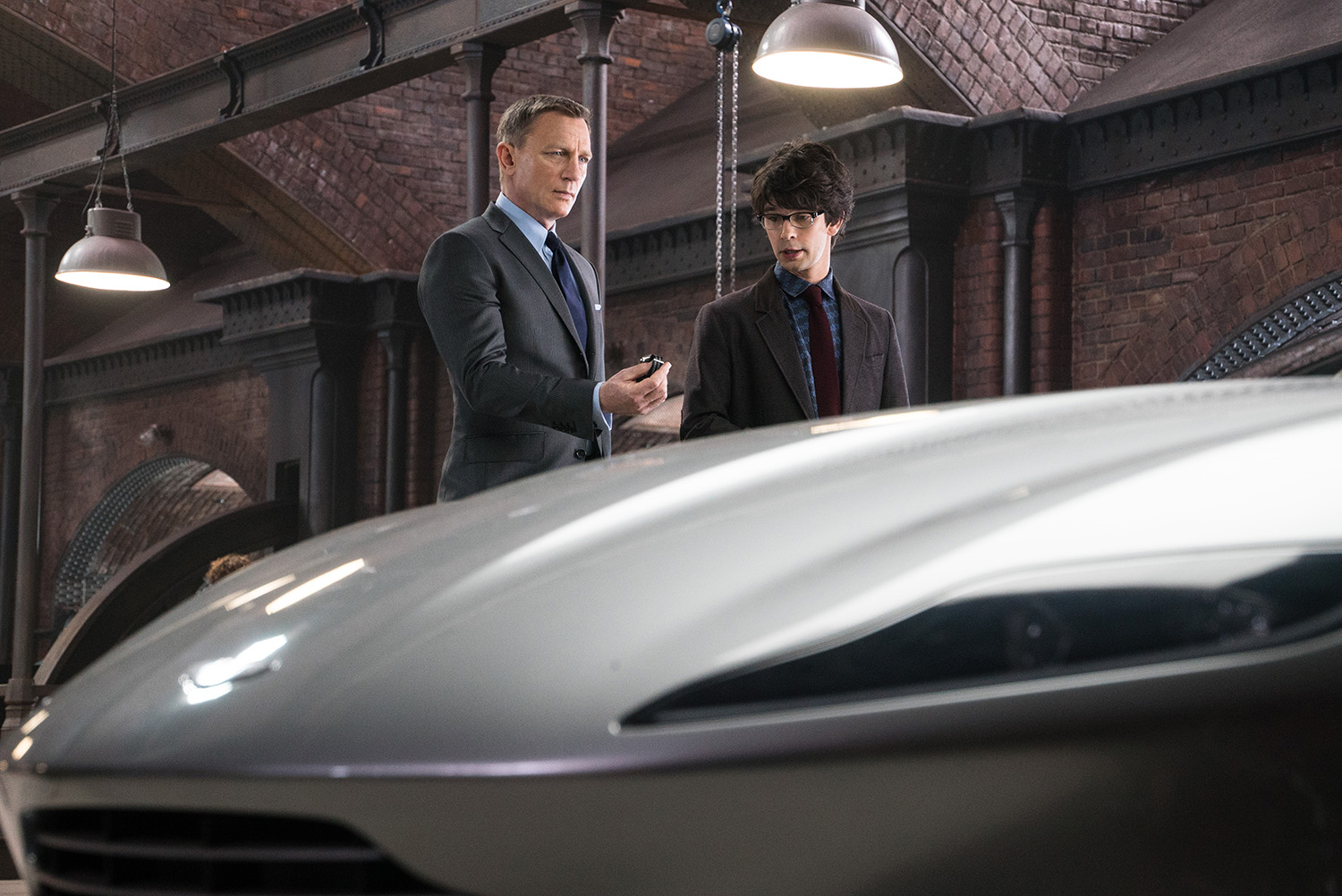
Miniaturisation was his speciality and he would have relished the world of Bond, where various aids to Escape and Evasion have to be incorporated into equipment such as 007’s trusty Omega watches. But could even a maverick genius like Clutty make the spy’s various Seamasters function as shown on screen, or are they just a fantasy product of the scriptwriters’ imagination? With an Omega about to play a pivotal role in No Time To Die, it’s as good a moment as any to look at the practicality of the world’s most versatile, and sometimes lethal, timepiece, and to give them a ‘Clutty Rating’ (CR) for the likelihood of the great gadget man being able to duplicate them.
RADIO SIGNAL DETONATOR
Over the past 25 years, Bond has frequently turned to his Omega to get him out of a tight spot by making something explode. In GoldenEye (1995), 007 uses the Seamaster’s HRV (Helium Release Valve) to initiate the timing sequence on several limpet mines. This is the watch acting as an on-off switch for the mines – which means Q has installed an actuating transmitter in the Seamaster. The limpets never actually blow – spoilsport Alex Trevelyan (Sean Bean) uses another click on the HRV to stop the countdown.
All this is eminently feasible, even with the limited space within an Omega. Researchers at Columbia University in the U.S., for instance, have built what they describe as the smallest frequency-modulated (FM) radio transmitter ever. Based on a graphene nanoelectromechanical system (NEMS), the microscopic device oscillates at a frequency of 100 MHz and, with a tiny antenna, could broadcast an activation signal. Even without using nanotechnology, traditional UHF transmitters can now be produced that are not much longer than a grain of rice.
No matter what type of signal generator Q opts for, a battery needs to be included to provide the power for the transmission. But this is also achievable – the University of California is working on gold nanowire batteries, which use rechargeable filaments thinner than a human hair as an energy sink. More practically, the Jenax company has created a thin, foldable and bendable lithium-ion battery called J.Flex. It isn’t difficult to envisage one of the latter fitting snugly against the inside of the caseback of a Q Branch Seamaster.
CR: 9/10
THE LASER BEAM
Lasers have a long association with James Bond, ever since Goldfinger (1964), when 007 was “expected to die” while being threatened with being split in two by a giant industrial CO2 laser.
By the time of GoldenEye (1995), the laser had shrunk enough to be concealed in 007’s Omega Seamaster. Bond uses the light beam to cut a very neat panel out of the steel floor of rogue 00 agent Alex Trevelyan’s armoured train and escape before the whole lot blows. The laser-watch reappears in Die Another Day (2002), with the light lance emerging from the crown, operated by pressing the face of the Omega, and is deployed by 007 to cut a hole in the ice outside of Gustave Graves’ frozen palace (admittedly an easier task than burning through metal floors).
Ridiculous? Well, German prop-maker and ‘laser hobbyist’ Patrick Priebe has succeeded in fitting a 1,500 milliwatt laser into a wrist-worn case. The beam is capable of puncturing balloons, scorching walls and cutting through duct tape. Burning steel?
Not so much. You need at least 300 watts to cut metal. However, it will ignite matches, and it doesn’t take much to imagine a Bond scenario where that would come in handy. Like 007’s version, Priebe’s laser-watch also tells the time – using a very crude LED digital display. A handsome Seamaster it is not. Despite companies such as Boeing and Lockheed Martin
working hard on miniaturising laser guidance and weapons systems, and the development of tiny (but weak) nano-lasers, it is likely that this is one 007 gadget that will remain in the realm of fiction for the time being.
CR: 2/10
PRIMARY EXPLOSIVE DETONATOR
In the pre-credits sequence of Die Another Day (2002), 007 lifts a tray of diamonds from an attaché case and underneath are blocks of C-4 explosive. He removes the Seamaster’s HRV, which has a small shaft or pin attached to it, and sticks this into the C-4. So what is it? I turned to Warrant Officer Kim Hughes, an ATO (Ammunition Technical Officer, bomb disposal expert in non-army parlance), who won the George Cross for his service in Afghanistan, to explain.
“Military grade explosives such as Semtex or C-4 are relatively insensitive compounds. They need a ‘kick’ to enable the chemical reaction to take place, which results in a rapid release of energy or explosion.”
So the detonator pin that Bond buries in the C-4 would contain a small amount of ‘primary’ explosive, triggered by heat from an electrical circuit. In the film, Bond initiates the blast by twisting the Omega’s bezel, which would send a signal to the HRV pin, causing a current to flow to a small wire. This instantly turns white-hot (think incandescent light bulbs) setting off the detonator charge, which in turn gives the energetic shock needed to make the main lump of C-4 go up. Is it realistic? Hughes agrees the principle is sound enough.
CR: 8/10

PRIMARY AND SECONDARY CHARGE
An example of 007’s watch containing both primary detonator and secondary explosive is found in Tomorrow Never Dies (1997), which also features an X-ray of the Seamaster in the credits, showing its elegant inner workings in all its mechanical glory.
On board the megalomaniac media tycoon Elliot Carver’s stealth ship, Bond slides a small, flat unit from the side of his watch. This has a coin-sized explosive charge at its centre, with a detonator contained in the outer casing.
Bond assembles an IED – Improvised Explosive Device – by placing a hand grenade, with the pin removed, in a glass jar. The fit is tight enough to stop the safety handle of the grenade flying off. Bond tapes the portable micro-bomb to the jar. Later on, Bond transmits a signal, using the Omega’s bezel, to the unit.
The small amount of plastic explosive in the gizmo is just enough to shatter glass, so the jar breaks open. This allows the grenade handle to release, causing a conflagration that ignites the drums of flammable liquid that all super-villains carelessly leave lying around. Simple.
CR: 9/10
THE GRAPPLING HOOK
A grappling hook and cable fired from a pistol appeared in the opening sequence of GoldenEye during the dam dive, but by The World Is Not Enough (1999), the device was incorporated into Bond’s Omega (along with ultra-bright micro-LEDs which provide illumination when Bond is stuck inside an inflatable anti-avalanche sphere). This piton system really would have been a challenge to Q Branch. But as ATO Kim Hughes pointed out to me, there is already a weapon that fires hooks trailing a cable: the taser.
Tasers use compressed gas to deploy the lines down which the electric shock travels, but shrinking the cylinders enough to fit into a Seamaster is quite an undertaking. However, ultracompact micro-and pico-cylinders do exist and are used in medicine in self-injection devices and inhalers. Whether they would generate enough pressure to drive a piton in concrete, however, is doubtful.
The BolaWrap100 uses a blank .380 cartridge as a propellant and the tether exits the weapon at 200m a second, faster than the human eye can see clearly. The drawback for Bond and his
Omega? The BolaWrap is the size of a mobile phone. Something tinier is needed. Enter the ANT, or actuating nano-transducer, which releases remarkable amounts of energy from gold particles which fly apart when hit by a beam from a miniscule nano-laser.
“It’s like an explosion,” said Dr Tao Ding from Cambridge’s Cavendish Laboratory. “We have hundreds of gold balls flying apart in a millionth of a second when water molecules inflate the polymers around them.” Such an explosion could be used to propel out the barb, while the same technology could be harnessed to produce an ANT “engine” to power the rotating bezel that rewinds the line attached to the hook.
And the cable needed to support the weight of 007? A 2020 update on the Omega would not use high-tensile steel (too bulky to incorporate in the watch) but rather a new material, such as Dyneema (15 times stronger than steel) – or perhaps one of the materials that laboratories are currently experimenting with, such as a filament that mimic the properties of spider silk in terms of tensile strength. The US Army, for example, is testing fibres called ‘Dragon Silk’, produced from modified silkworms, which are strong enough to be woven into bulletproof vests.
CR: 3/10

PRIMARY EXPLOSIVE
The Q Branch Omega watches were retired from active duty (other than for telling the time) for the first run of the Daniel Craig movies, but in Spectre (2015) one watch was up to its old tricks. When he is tortured by Blofeld, Bond manages to remove his NATO-strapped Seamaster and spins the crown, so that the hour markers flash red. This initiates a countdown that culminates in a blast that blows Blofeld off his chair and causes significant facial damage to the villain.
Kim Hughes pointed out that it would be difficult to pack enough explosive into the Spectre watch to cause such a big bang.
However, he did concede that modern hard PBX (Plastic Bonded Explosive) could be machined or cast – complete with engraving – to replace entirely the caseback of the Seamaster (it would, he adds, also need a detonator and a battery to be fully operational).
He reckoned this might be enough to, say, blow off a hand. Whether one would want to walk around all day wearing such a timepiece is debatable. Of course, he is assuming that Q wouldn’t have access to types of PBX more powerful than those commercially available.
CR: 6/10
AND FOR ITS NEXT TRICK?
A lightweight titanium Omega Seamaster Diver 300M chronometer will certainly play a part in the next 007 outing, No Time To Die. Rumour has it that Q Branch has been hard at work creating new surprises to incorporate into Bond’s trusty timepiece. For the moment, exactly what those surprises are is under wraps. Time will tell.
The latest James Bond adventure, No Time To Die, is out in cinemas Thursday, November 11. 007.com
Subscribe to the Newsletter
Recommended for you
Watches & Wonders 2024 Showcase: Hermès
We head to Geneva for the Watches & Wonders exhibition; a week-long horological blockbuster featuring the hottest new drops, and no shortage of hype.
By Josh Bozin
July 24, 2024
Watch This Space: Mike Nouveau
Meet the game-changing horological influencers blazing a trail across social media—and doing things their own way.
By Josh Bozin
July 22, 2024
You may also like.
By Josh Bozin
24/07/2024
You may also like.
5 Lounge Chairs That Add Chic Seating to Your Space
Daybeds, the most relaxed of seating solutions, offer a surprising amount of utility.
Chaise longue, daybed, recamier, duchesse brisée—elongated furniture designed for relaxing has a roster of fancy names. While the French royal court of Louis XIV brought such pieces to prominence in fashionable European homes, the general idea has been around far longer: The Egyptian pharaohs were big fans, while daybeds from China’s Ming dynasty spurred all those Hollywood Regency fretwork pieces that still populate Palm Beach living rooms. Even Mies van der Rohe, one of design’s modernist icons, got into the lounge game with his Barcelona couch, a study of line and form that holds up today.
But don’t get caught up in who invented them, or what to call them. Instead, consider their versatility: Backless models are ideal in front of large expanses of glass (imagine lazing on one with an ocean view) or at the foot of a bed, while more structured pieces can transform any corner into a cozy reading nook. Daybeds may be inextricably linked to relaxation, but from a design perspective, they put in serious work.

Emmy, Egg Collective
In designing the Emmy chaise, the Egg Collective trio of Stephanie Beamer, Crystal Ellis and Hillary Petrie, who met as students at Washington University in St. Louis, aimed for versatility. Indeed, the tailored chaise looks equally at home in a glass skyscraper as it does in a turn-of-the-century town house. Combining the elegance of a smooth, solid oak or walnut frame with the comfort of bolsters and cushioned upholstery or leather, it works just as well against a wall or at the heart of a room. From around $7,015; Eggcollective.com
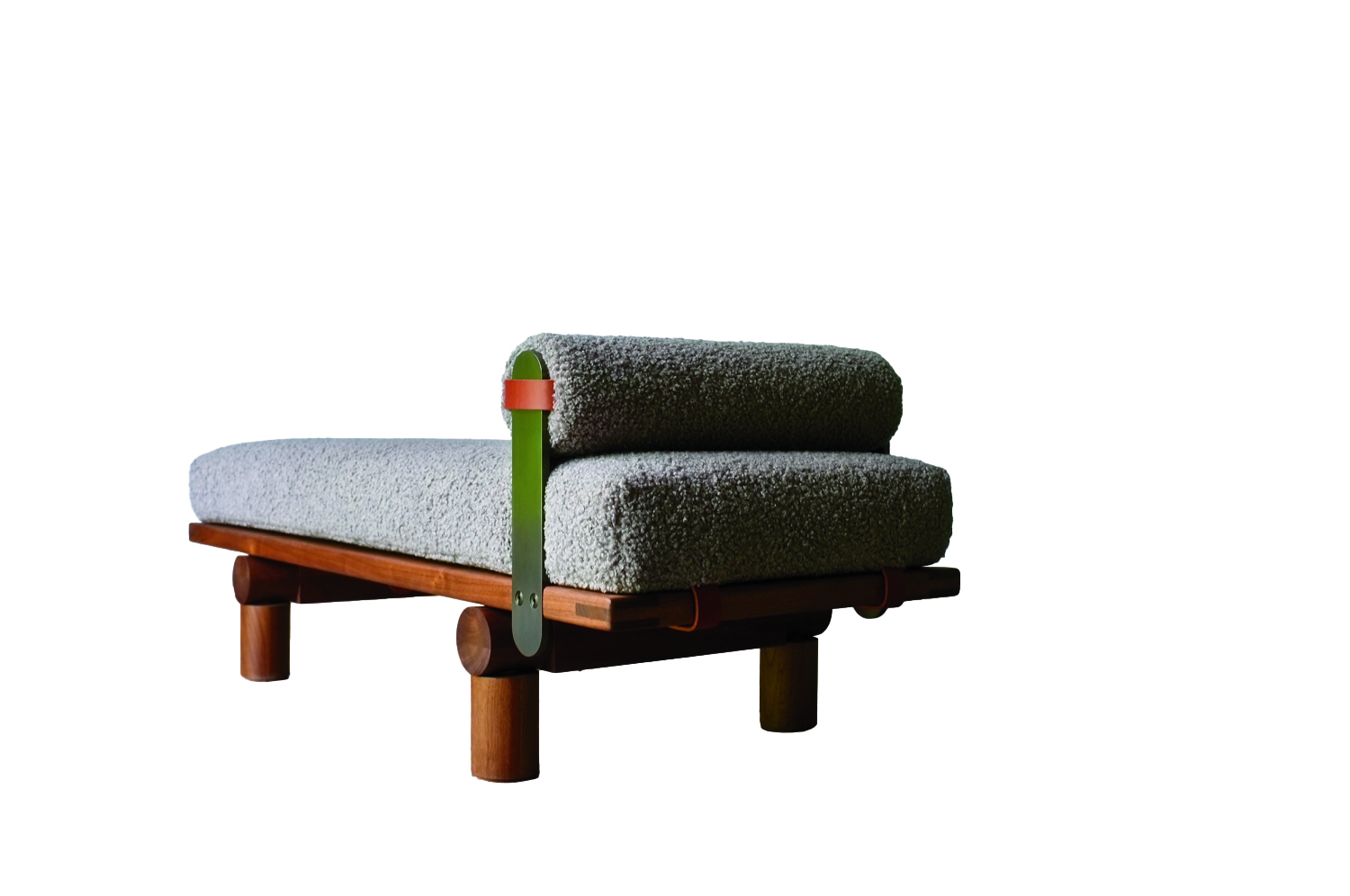 Plum, Michael Robbins
Plum, Michael Robbins
Woodworker Michael Robbins is the quintessential artisan from New York State’s Hudson Valley in that both his materials and methods pay homage to the area. In fact, he describes his style as “honest, playful, elegant and reflective of the aesthetic of the Hudson Valley surroundings”. Robbins crafts his furniture by hand but allows the wood he uses to help guide the look of a piece. (The studio offers eight standard finishes.) The Plum daybed, brought to life at Robbins’s workshop, exhibits his signature modern rusticity injected with a hint of whimsy thanks to the simplicity of its geometric forms. Around $4,275; MichaelRobbins.com
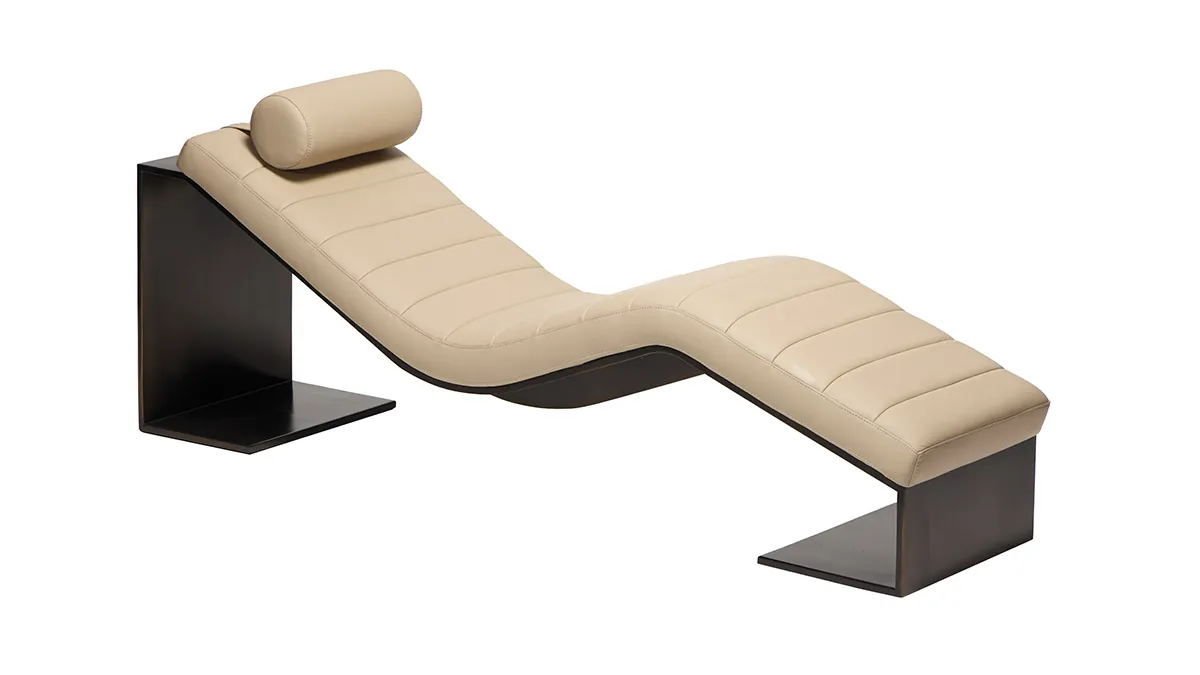
Kimani, Reda Amalou Design
French architect and designer Reda Amalou acknowledges the challenge of creating standout seating given the number of iconic 20th-century examples already in existence. Still, he persists—and prevails. The Kimani, a bent slash of a daybed in a limited edition of eight pieces, makes a forceful statement. Its leather cushion features a rolled headrest and rhythmic channel stitching reminiscent of that found on the seats of ’70s cars; visually, these elements anchor the slender silhouette atop a patinated bronze base with a sure-handed single line. The result: a seamless contour for the body. Around $33,530; RedaAmalou
Dune, Workshop/APD
From a firm known for crafting subtle but luxurious architecture and interiors, Workshop/APD’s debut furniture collection is on point. Among its offerings is the leather-wrapped Dune daybed. With classical and Art Deco influences, its cylindrical bolsters are a tactile celebration, and the peek of the curved satin-brass base makes for a sensual surprise. Associate principal Andrew Kline notes that the daybed adeptly bridges two seating areas in a roomy living space or can sit, bench-style, at the foot of a bed. From $13,040; Workshop/ APD
Sherazade, Edra
Designed by Francesco Binfaré, this sculptural, minimalist daybed—inspired by the rugs used by Eastern civilizations—allows for complete relaxation. Strength combined with comfort is the name of the game here. The Sherazade’s structure is made from light but sturdy honeycomb wood, while next-gen Gellyfoam and synthetic wadding aid repose. True to Edra’s amorphous design codes, it can switch configurations depending on the user’s mood or needs; for example, the accompanying extra pillows—one rectangular and one cylinder shaped— interchange to become armrests or backrests. From $32,900; Edra
You may also like.
By Josh Bozin
24/07/2024
22/07/2024
Watches & Wonders 2024 Showcase: Hermès
We head to Geneva for the Watches & Wonders exhibition; a week-long horological blockbuster featuring the hottest new drops, and no shortage of hype.
With Watches & Wonders 2024 well and truly behind us, we review some of the novelties Hermès presented at this year’s event.
—
HERMÈS

Moving away from the block colours and sporty aesthetic that has defined Hermès watches in recent years, the biggest news from the French luxury goods company at Watches & Wonders came with the unveiling of its newest collection, the Hermès Cut.
It flaunts a round bezel, but the case middle is nearer to a tonneau shape—a relatively simple design that, despite attracting flak from some watch aficionados, works. While marketed as a “women’s watch”, the Cut has universal appeal thanks to its elegant package and proportions. It moves away from the Maison’s penchant for a style-first product; it’s a watch that tells the time, not a fashion accessory with the ability to tell the time.
Hermès gets the proportions just right thanks to a satin-brushed and polished 36 mm case, PVD-treated Arabic numerals, and clean-cut edges that further accentuate its character. One of the key design elements is the positioning of the crown, boldly sitting at half-past one and embellished with a lacquered or engraved “H”, clearly stamping its originality. The watch is powered by a Hermès Manufacture movement H1912, revealed through its sapphire crystal caseback. In addition to its seamlessly integrated and easy-wearing metal bracelet, the Cut also comes with the option for a range of coloured rubber straps. Together with its clever interchangeable system, it’s a cinch to swap out its look.
It will be interesting to see how the Hermès Cut fares in coming months, particularly as it tries to establish its own identity separate from the more aggressive, but widely popular, Ho8 collection. Either way, the company is now a serious part of the dialogue around the concept of time.
—
Read more about this year’s Watches & Wonders exhibition at robbreport.com.au
You may also like.
22/07/2024
Living La Vida Lagerfeld
The world remembers him for fashion. But as a new tome reveals, the iconoclastic designer is defined as much by extravagant, often fantastical, homes as he is clothes.
“Lives, like novels, are made up of chapters”, the world-renowned bibliophile, Karl Lagerfeld, once observed.
Were a psychological-style novel ever to be written about Karl Lagerfeld’s life, it would no doubt give less narrative weight to the story of his reinvigoration of staid fashion houses like Chloe, Fendi and Chanel than to the underpinning leitmotif of the designer’s constant reinvention of himself.
In a lifetime spanning two centuries, Lagerfeld made and dropped an ever-changing parade of close friends, muses, collaborators and ambiguous lovers, as easily as he changed his clothes, his furniture… even his body. Each chapter of this book would be set against the backdrop of one of his series of apartments, houses and villas, whose often wildly divergent but always ultra-luxurious décor reflected the ever-evolving personas of this compulsively public but ultimately enigmatic man.
With the publication of Karl Lagerfeld: A Life in Houses these wildly disparate but always exquisite interiors are presented for the first time together as a chronological body of work. The book indeed serves as a kind of visual novel, documenting the domestic dreamscapes in which the iconic designer played out his many lives, while also making a strong case that Lagerfeld’s impact on contemporary interior design is just as important, if not more so, than his influence on fashion.

In fact, when the first Lagerfeld interior was featured in a 1968 spread for L’OEil magazine, the editorial describes him merely as a “stylist”. The photographs of the apartment in an 18th-century mansion on rue de Université, show walls lined with plum-coloured rice paper, or lacquered deepest chocolate brown in sharp contrast to crisp, white low ceilings that accentuated the horizontality that was fashionable among the extremely fashionable at the time. Yet amid this setting of aggressively au courant modernism, the anachronistic pops of Art Nouveau and Art Deco objects foreshadow the young Karl’s innate gift for creating strikingly original environments whose harmony is achieved through the deft interplay of contrasting styles and contexts.
Lagerfeld learned early on that presenting himself in a succession of gem-like domestic settings was good for crafting his image. But Lagerfeld’s houses not only provided him with publicity, they also gave him an excuse to indulge in his greatest passion. Shopping!
By 1973, Lagerfeld was living in a new apartment at Place Saint–Sulpice where his acquisition of important Art Deco treasures continued unabated. Now a bearded and muscular disco dandy, he could most often be found in the louche company of the models, starlets and assorted hedonistic beauties that gathered around the flamboyant fashion illustrator Antonio Lopez. Lagerfeld was also in the throes of a hopeless love affair with Jacques de Bascher whose favours he reluctantly shared with his nemesis Yves Saint Laurent.

He painted the rooms milky white and lined them with specially commissioned carpets—the tawny patterned striations of which invoked musky wild animal pelts. These lent a stark relief to the sleek, machine-age chrome lines of his Deco furnishings. To contemporary eyes it remains a strikingly original arrangement that subtly conveys the tensions at play in Lagerfeld’s own life: the cocaine fuelled orgies of his lover and friends, hosted in the pristine home of a man who claimed that “a bed is for one person”.
In 1975, a painful falling out with his beloved Jacques, who was descending into the abyss of addiction, saw almost his entire collection of peerless Art Deco furniture, paintings and objects put under the auctioneer’s hammer. This was the first of many auction sales, as he habitually shed the contents of his houses along with whatever incarnation of himself had lived there. Lagerfeld was dispassionate about parting with these precious goods. “It’s collecting that’s fun, not owning,” he said. And the reality for a collector on such a Renaissance scale, is that to continue buying, Lagerfeld had to sell.
Of all his residences, it was the 1977 purchase of Hôtel Pozzo di Borgo, a grand and beautifully preserved 18th-century house, that would finally allow him to fulfill his childhood fantasies of life in the court of Madame de Pompadour. And it was in this aura of Rococó splendour that the fashion designer began to affect, along with his tailored three-piece suits, a courtier’s ponytailed and powdered coif and a coquettish antique fan: marking the beginning of his transformation into a living, breathing global brand that even those with little interest in fashion would immediately recognise.
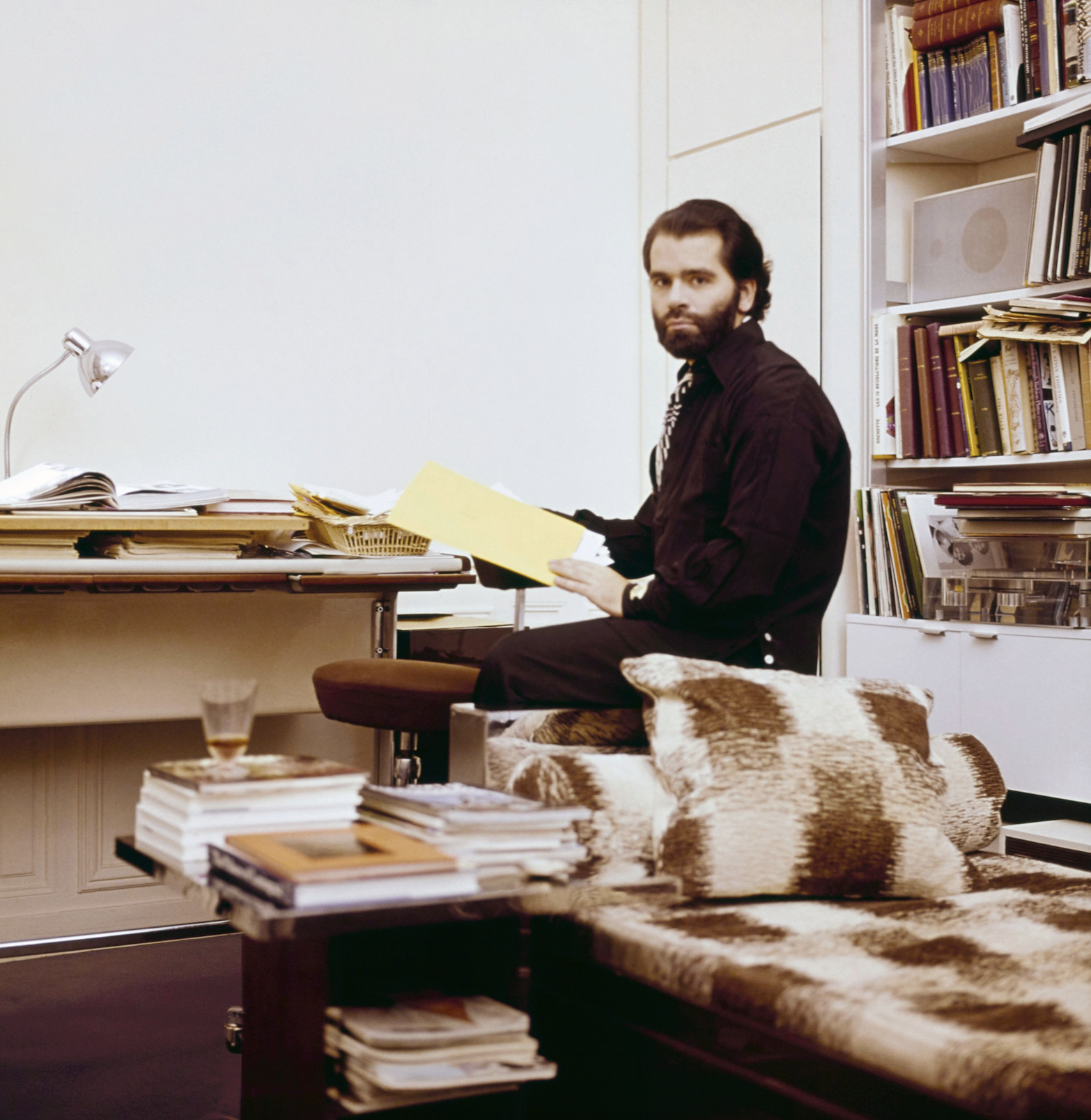
Lagerfeld’s increasing fame and financial success allowed him to indulge in an unprecedented spending frenzy, competing with deep-pocketed institutions like the Louvre to acquire the finest, most pedigreed pearls of the era—voluptuously carved and gilded bergères; ormolu chests; and fleshy, pastel-tinged Fragonard idylls—to adorn his urban palace. His one-time friend André Leon Talley described him in a contemporary article as suffering from “Versailles complex”.
However, in mid-1981, and in response to the election of left-wing president, François Mitterrand, Lagerfeld, with the assistance of his close friend Princess Caroline, became a resident of the tax haven of Monaco. He purchased two apartments on the 21st floor of Le Roccabella, a luxury residential block designed by Gio Ponti. One, in which he kept Jacques de Bascher, with whom he was now reconciled, was decorated in the strict, monochromatic Viennese Secessionist style that had long underpinned his aesthetic vocabulary; the other space, though, was something else entirely, cementing his notoriety as an iconoclastic tastemaker.
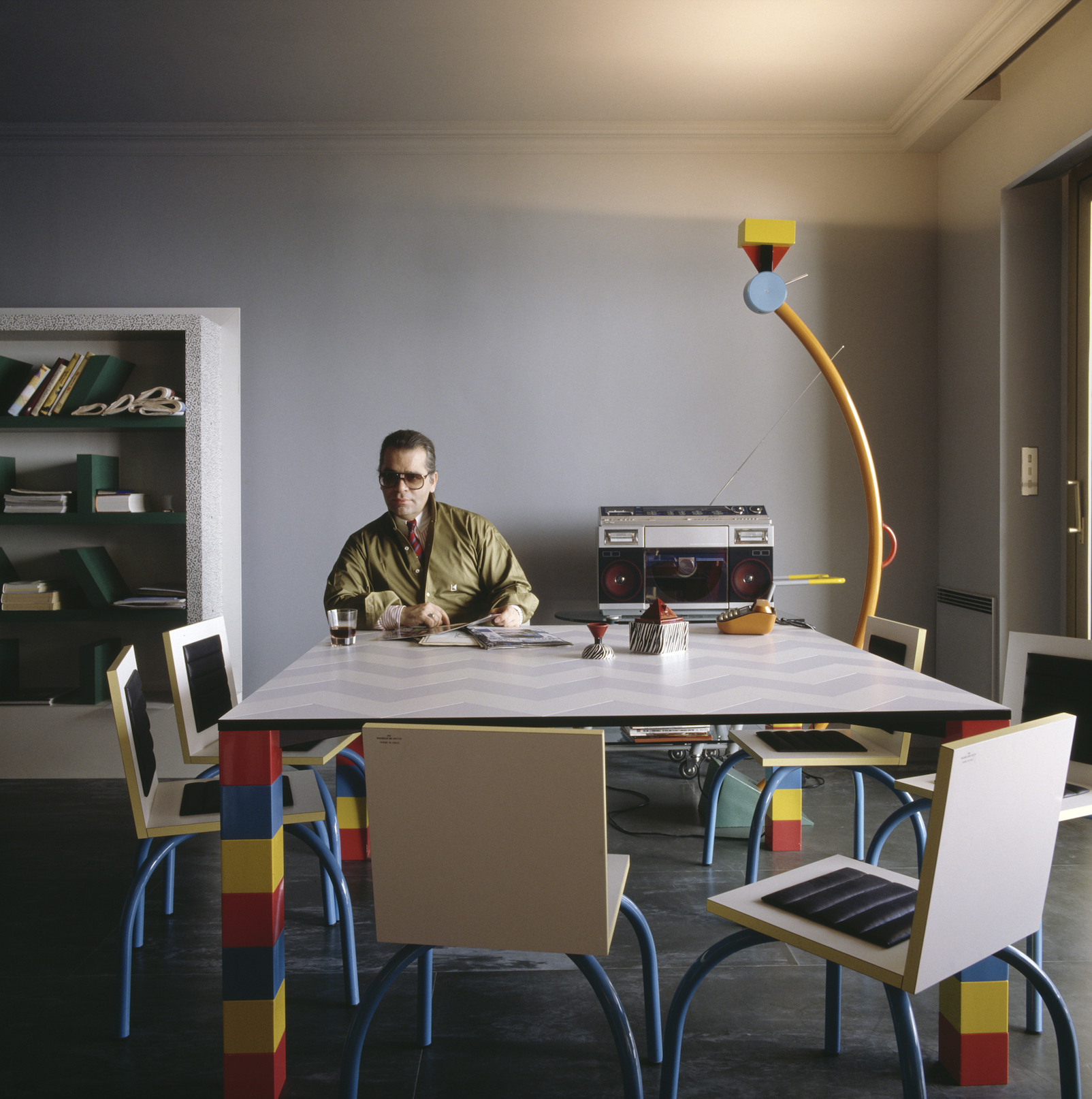
Lagerfeld had recently discovered the radically quirky designs of the Memphis Group led by Ettore Sottsass, and bought the collective’s entire first collection and had it shipped to Monaco. In a space with no right angles, these chaotically colourful, geometrically askew pieces—centred on Masanori Umeda’s famous boxing ring—gave visitors the disorientating sensation of having entered a corporeal comic strip. By 1991, the novelty of this jarring postmodern playhouse had inevitably worn thin and once again he sent it all to auction, later telling a journalist that “after a few years it was like living in an old Courrèges. Ha!”

In 1989, de Bascher died of an AIDS-related illness, and while Lagerfeld’s career continued to flourish, emotionally the famously stoic designer was struggling. In 2000, a somewhat corpulent Lagerfeld officially ended his “let them eat cake” years at the Hôtel Pozzo di Borgo, selling its sumptuous antique fittings in a massive headline auction that stretched over three days. As always there were other houses, but now with his longtime companion dead, and his celebrity metastasising making him a target for the paparazzi, he began to look less for exhibition spaces and more for private sanctuaries where he could pursue his endless, often lonely, work.
His next significant house was Villa Jako, named for his lost companion and built in the 1920s in a nouveau riche area of Hamburg close to where he grew up. Lagerfeld shot the advertising campaign for Lagerfeld Jako there—a fragrance created in memorial to de Bascher. The house featured a collection of mainly Scandinavian antiques, marking the aesthetic cusp between Art Nouveau and Art Deco. One of its rooms Lagerfeld decorated based on his remembrances of his childhood nursery. Here, he locked himself away to work—tellingly—on a series of illustrations for the fairy tale, The Emperor’s New Clothes. Villa Jako was a house of deep nostalgia and mourning.
But there were more acts—and more houses—to come in Lagerfeld’s life yet. In November 2000, upon seeing the attenuated tailoring of Hedi Slimane, then head of menswear at Christian Dior, the 135 kg Lagerfeld embarked on a strict dietary regime. Over the next 13 months, he melted into a shadow of his former self. It is this incarnation of Lagerfeld—high white starched collars; Slimane’s skintight suits, and fingerless leather gloves revealing hands bedecked with heavy silver rings—that is immediately recognisable some five years after his death.
The 200-year-old apartment in Quái Voltaire, Paris, was purchased in 2006, and after years of slumber Lagerfeld—a newly awakened Hip Van Winkle—was ready to remake it into his last modernist masterpiece. He designed a unique daylight simulation system that meant the monochromatic space was completely without shadows—and without memory. The walls were frosted and smoked glass, the floors concrete and silicone; and any hint of texture was banned with only shiny, sleek pieces by Marc Newson, Martin Szekely and the Bouroullec Brothers permitted. Few guests were allowed into this monastic environment where Lagerfeld worked, drank endless cans of Diet Coke and communed with Choupette, his beloved Birman cat, and parts of his collection of 300,000 books—one of the largest private collections in the world.

Lagerfeld died in 2019, and the process of dispersing his worldly goods is still ongoing. The Quái Voltaire apartment was sold this year for US$10.8 million (around $16.3 million). Now only the rue de Saint-Peres property remains within the Lagerfeld trust. Purchased after Quái Voltaire to further accommodate more of his books—35,000 were displayed in his studio alone, always stacked horizontally so he could read the titles without straining his neck—and as a place for food preparation as he loathed his primary living space having any trace of cooking smells. Today, the rue de Saint-Peres residence is open to the public as an arts performance space and most fittingly, a library.
You may also like.
By Josh Bozin
24/07/2024
Watch This Space: Mike Nouveau
Meet the game-changing horological influencers blazing a trail across social media—and doing things their own way.
In the thriving world of luxury watches, few people own a space that offers unfiltered digital amplification. And that’s precisely what makes the likes of Brynn Wallner, Teddy Baldassarre, Mike Nouveau and Justin Hast so compelling.
These thought-provoking digital crusaders are now paving the way for the story of watches to be told, and shown, in a new light. Speaking to thousands of followers on the daily—mainly via TikTok, Instagram and YouTube—these progressive commentators represent the new guard of watch pundits. And they’re swaying the opinions, and dollars, of the up-and-coming generations who now represent the target consumer of this booming sector.
—
MIKE NOUVEAU
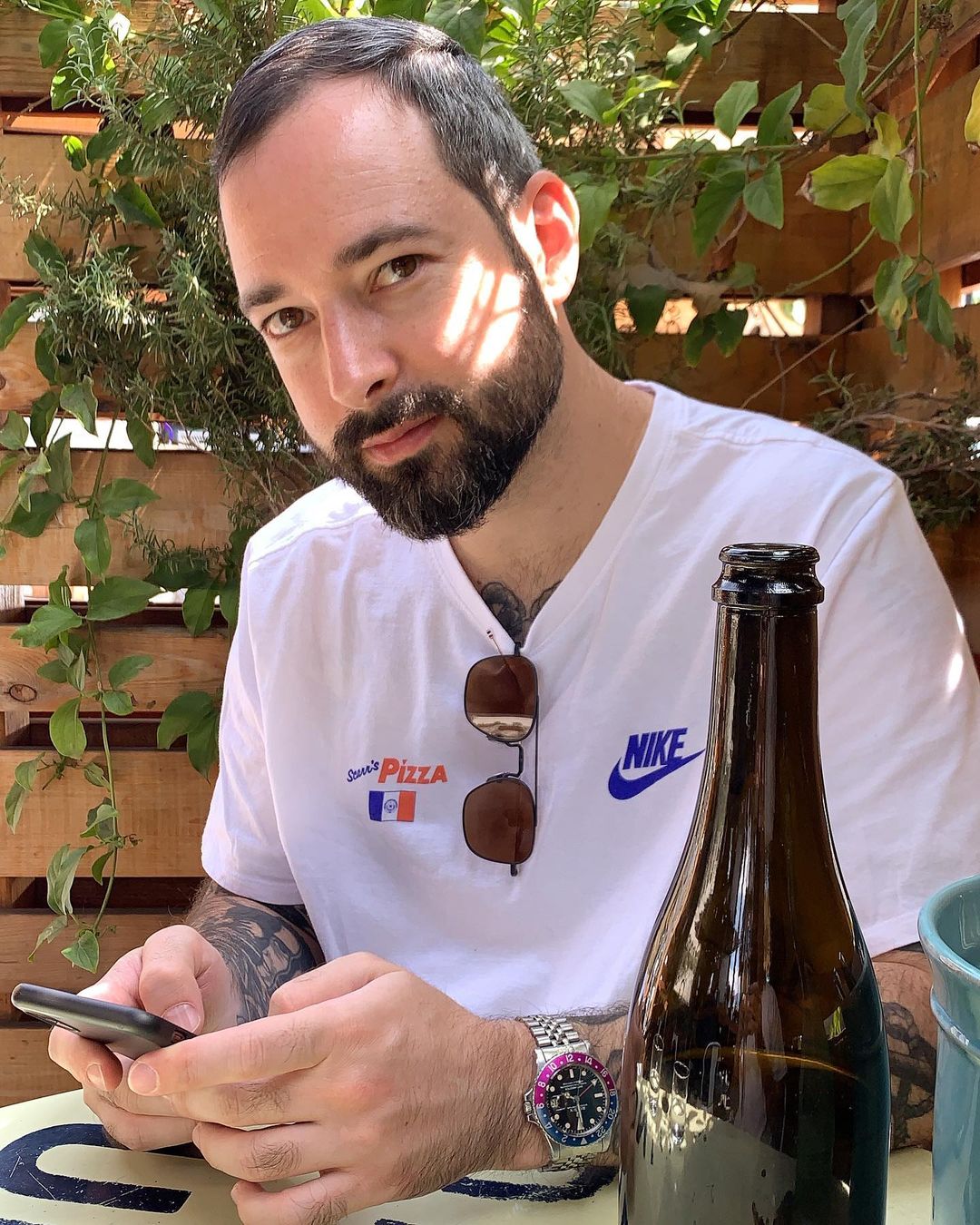
Can we please see what’s on the wrist? That’s the question that catapulted Mike Nouveau into watch stardom, thanks to his penchant for highlighting incredibly rare timepieces across his TikTok account of more than 400,000 followers. When viewing Nouveau’s attention-grabbing video clips—usually shot in a New York City neighbourhood—it’s not uncommon to find him wrist-rolling some of the world’s rarest timepieces, like the million-dollar Cartier Cheich (a clip he posted in May).
But how did someone without any previous watch experience come to amass such a cult following, and in the process gain access to some of the world’s most coveted timepieces? Nouveau admits had been a collector for many years, but moved didn’t move into horology full-time until 2020, when he swapped his DJing career for one as a vintage watch specialist.
“I probably researched for a year before I even bought my first watch,” says Nouveau, alluding to his Rolex GMT Master “Pepsi” ref. 1675 from 1967, a lionised timepiece in the vintage cosmos. “I would see deals arise that I knew were very good, but they weren’t necessarily watches that I wanted to buy myself. I eventually started buying and selling, flipping just for fun because I knew how to spot a good deal.”
Nouveau claims that before launching his TikTok account in the wake of Covid-19, no one in the watch community knew he existed. “There really wasn’t much watch content, if any, on TikTok before I started posting, especially talking about vintage watches. There’s still not that many voices for vintage watches, period,” says Nouveau. “It just so happens that my audience probably skews younger, and I’d say there are just as many young people interested in vintage watches as there are in modern watches.”
View this post on Instagram
Nouveau recently posted a video to his TikTok account revealing that the average price of a watch purchased by Gen Z is now almost US$11,000 (around $16,500), with 41 percent of them coming into possession of a luxury watch in the past 12 months.
“Do as much independent research as you can [when buying],” he advises. “The more you do, the more informed you are and the less likely you are to make a mistake. And don’t bring modern watch expectations to the vintage world because it’s very different. People say, ‘buy the dealer’, but I don’t do that. I trust myself and myself only.”
—
Read more about the influencers shaking up horology here with Justin Hast, Brynn Wallner and Teddy Baldassare.
You may also like.
By Josh Bozin
24/07/2024
This Pristine 1960 Ferrari 250 Spider Could Fetch $24 Million at Auction
The car wears the same colours and has the same engine it left the factory with.
Some Ferraris are just a little bit more important than others.
Take, for example, the 1960 250 GT SWB California that RM Sotheby’s is auctioning off during this year’s Monterey Car Week. Any example of the open-top beauty would attract interest, but this one just so happens to be the first one that was built.
The 250 is one of the most legendary series of cars in Ferrari history. Between 1952 and 1964, the company released 21 different 250 models—seven for racetracks, 14 for public roads—of which the “Cali Spider” might be the most well regarded, thanks to its potent V-12 and a Pininfarina-penned design that is one of the most beautiful bodies to grace an automobile. The roadster, which was specifically built for the U.S., made its debut in 1957 as a long-wheel-base model (LWB), but it wasn’t until the SWB model debut in 1960 that it became clear how special it was. This example isn’t just the first to roll off the line. It’s the actual car that was used to introduce the world to the model at the 1960 Geneva Motor Show.

Just 56 examples of the 250 GT SWB California Spider would be built by Scaglietti during the three years it was in production. The first of those, chassis 1795 GT, is finished in a glossy coat of Grigio. The two-door had a red leather interior at Geneva but was returned to the factory and re-outfitted with black leather upholstery before being delivered to its original owner, British race car driver John Gordon Bennet. Six-and-a-half decades later the car looks identical to how it did when it left the factory the second time.

In addition to its original bodywork, the chassis 1795 GT features its original engine, gearbox, and rear axle. That mill is the competition-spec Tipo 168, a 3.0-litre V-12 that makes 196.1 kW. That may not sound like much by today’s standards, but, when you consider that the 250 GT SWB California Spider tips the scales around 952 kilograms, it’s more than enough.
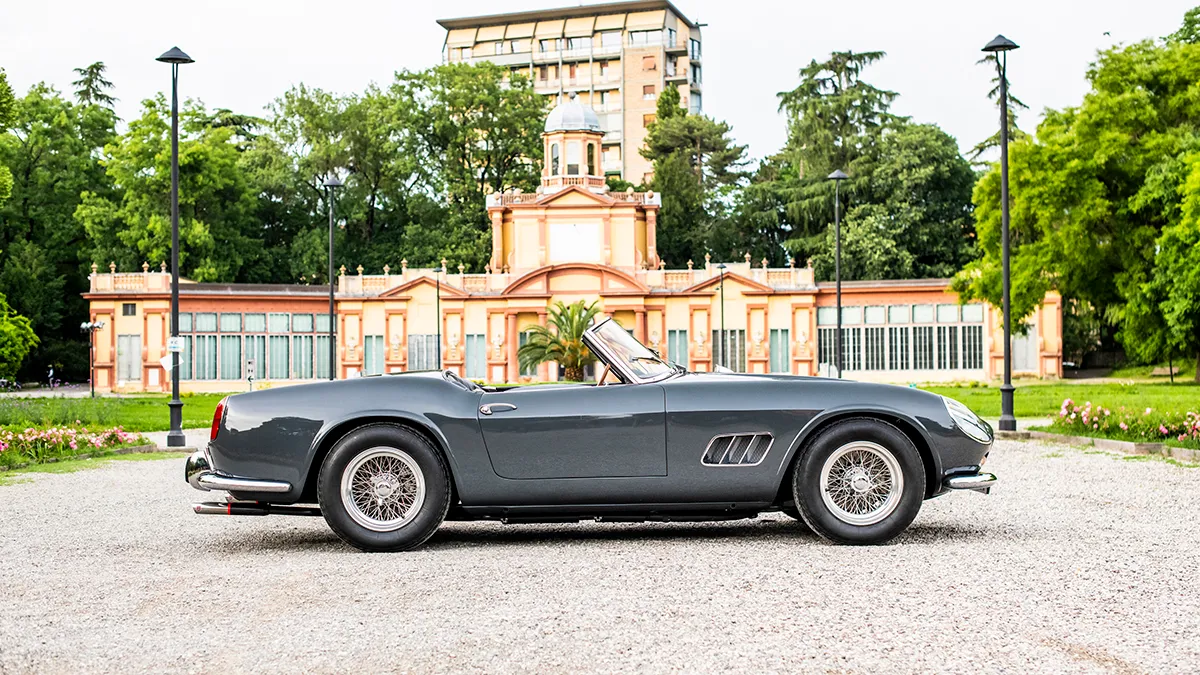
The first 250 GT SWB California Spider is scheduled to go up for bid during RM Sotheby’s annual Monterey Car Week auction, which runs from Thursday, August 15, to Saturday, August 17. Unsurprisingly, the house has quite high hopes for the car. The car carries an estimate of between $24 million and $26 million, which could make it one of the most expensive cars ever sold at auction.
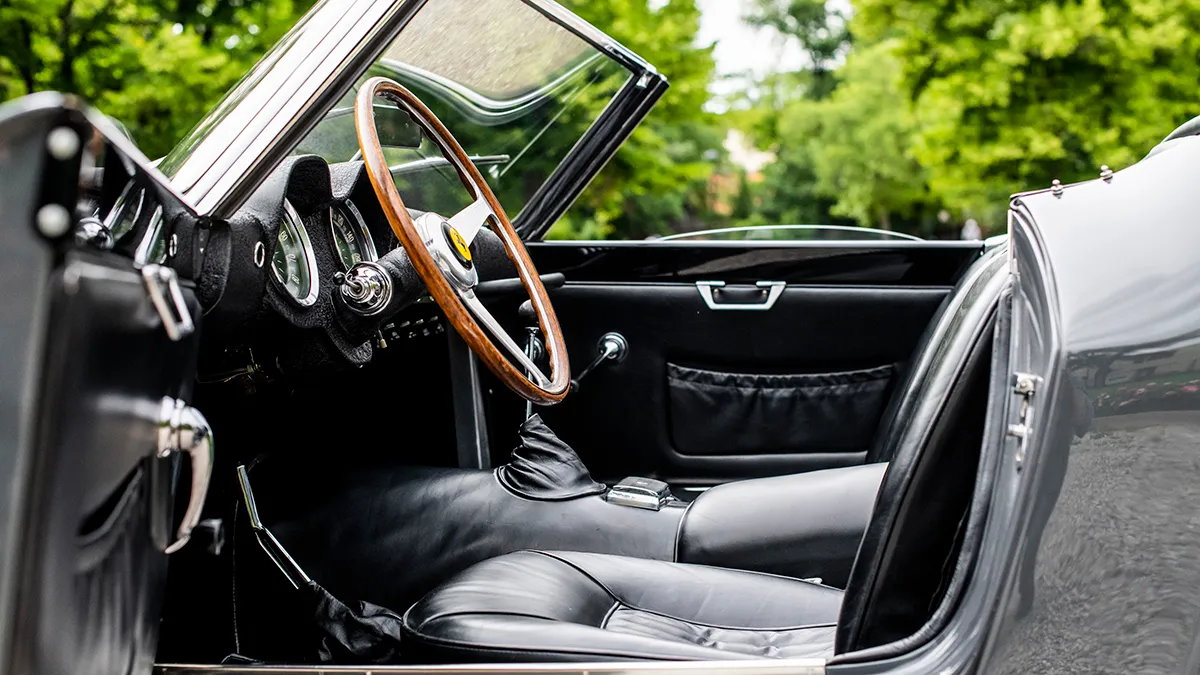
You may also like.
By Josh Bozin
24/07/2024











